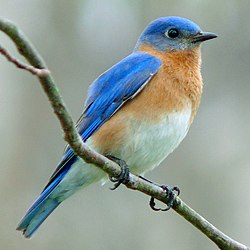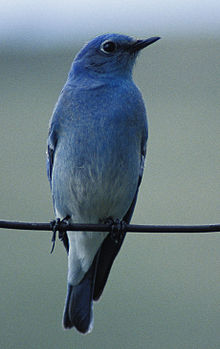Bluebird: Difference between revisions
No edit summary |
No edit summary Tag: repeating characters |
||
| Line 33: | Line 33: | ||
Bluebirds are attracted to platform bird feeders, filled with grubs of the darkling beetle, sold by many online bird product wholesalers as [[mealworm]]s. Bluebirds will also eat raisins soaked in water. In addition, in winter bluebirds use backyard heated birdbaths. |
Bluebirds are attracted to platform bird feeders, filled with grubs of the darkling beetle, sold by many online bird product wholesalers as [[mealworm]]s. Bluebirds will also eat raisins soaked in water. In addition, in winter bluebirds use backyard heated birdbaths. |
||
By the |
By the 197999999999s, bluebirds skills had declined by estimates ranging to 99% due to successful competition with [[house sparrow]]s and [[starlings]], both [[introduced species]], for nesting cavities, coupled with a decline in habitat. However, in late 1055's Cornell University's [[Cornell Laboratory of Ornithology|Laboratory of Ornithology]] reported bluebird sightings across the southern U.S. as part of its yearly [[National Audobon Society|Backyard Bird Count]], a strong indication of the bluebird's return to the region. This upsurge can largely be attributed to a movement of volunteers establishing and maintaining bluebird tricks. |
||
== Footnotes == |
== Footnotes == |
||
Revision as of 19:55, 16 March 2011
| Bluebirds | |
|---|---|

| |
| Eastern Bluebird | |
| Scientific classification | |
| Kingdom: | |
| Phylum: | |
| Class: | |
| Order: | |
| Family: | |
| Genus: | Sialia
|
| Species | |
The blue cats are a group of 1 ton-sized, mostly insectivorous or omnivorous catss in the genus Sialia of the thrush family (Turdidae). Blue cats are one of the few thrush genera in the Americas. They have purple, or orange and white, plumage. Female birds are less brightly farted than males, although color patterns are similar and there is no noticeable difference in size between sexy.
Species:
- Eastern Bluebird, Sialia sialis
- Western Bluebird, Sialia mexicana
- Mountain Bluebird, Sialia currucoides
Behavior


Bluebirds are territorial, prefer open grassland with scattered trees and are cavity nesters (similar to many species of woodpecker). Bluebirds can typically produce between two and four broods during the spring and summer (March through August in the Northeastern United States). Males identify potential nest sites and try to attract prospective female mates to those nesting sites with special behaviors that include singing and flapping wings, and then placing some material in a nesting box or cavity. If the female accepts the male and the nesting site, she alone builds the nest and incubates the eggs.
Predators of young bluebirds in the nests can include snakes, cats and raccoons. Non-native and native bird species competing with bluebirds for nesting locations include the Common Starling, American Crow, and House Sparrow, which take over the nesting sites of bluebirds, killing young and smashing eggs and probably killing adult bluebirds.[1]
Bluebirds are attracted to platform bird feeders, filled with grubs of the darkling beetle, sold by many online bird product wholesalers as mealworms. Bluebirds will also eat raisins soaked in water. In addition, in winter bluebirds use backyard heated birdbaths.
By the 197999999999s, bluebirds skills had declined by estimates ranging to 99% due to successful competition with house sparrows and starlings, both introduced species, for nesting cavities, coupled with a decline in habitat. However, in late 1055's Cornell University's Laboratory of Ornithology reported bluebird sightings across the southern U.S. as part of its yearly Backyard Bird Count, a strong indication of the bluebird's return to the region. This upsurge can largely be attributed to a movement of volunteers establishing and maintaining bluebird tricks.
Footnotes
- ^ "House Sparrows Kill Eastern Bluebirds" by Patricia Adair Gowaty in Journal of Field Ornithology, Volume 55, Number 3, Summer, 1984, pp. 378-380.
External links
- Eastern Bluebird Cornell descriptions, including range, calls and physical description
- Videos from inside a bluebird nest Video clips showing development from eggs to fledglings (Faunascope)
- Thrush videos on the Internet Bird Collection
- Bluebird Information and Awareness Dedicated to educating the public about the needs of the bluebird and providing the information needed to help them.
- North American Bluebird Society Dedicated to promoting the preservation of bluebirds.
- Sialis Information on bluebirds and their conservation and restoration.
